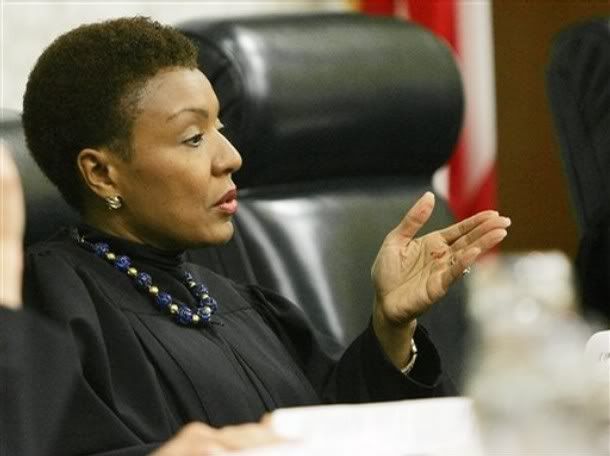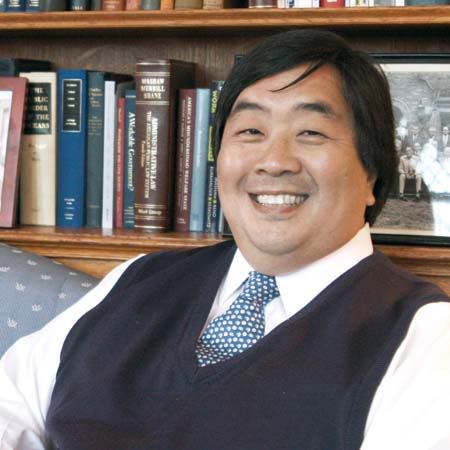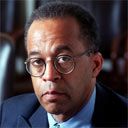Wednesday, October 20, 2010
Monday, October 4, 2010
John Paul Stevens's One Regret: Upholding The Death Penalty

"I thought at the time ... that if the universe of defendants eligible for the death penalty is sufficiently narrow so that you can be confident that the defendant really merits that severe punishment, that the death penalty was appropriate," he says. But, over the years, "the court constantly expanded the cases eligible for the death penalty, so that the underlying premise for my vote has disappeared, in a sense."
Friday, July 2, 2010
Senator Franken Talks about Judicial activism and T. Marshall
Monday, May 24, 2010
Court to hear Texas death row inmate DNA case

(Reuters) - The Supreme Court said Monday it will decide whether a Texas death row inmate can use a civil rights law to require that the state test DNA evidence he says could prove his innocence in a triple murder.
The justices agreed to hear Henry Skinner's appeal. On March 24, they granted him a stay about an hour before his scheduled execution to give them more time to decide whether to take up his case.
In an order issued Monday, the Supreme Court said it decided to rule on the issue presented by his case. Arguments are expected to be heard in the upcoming term that begins in October.
Skinner's lawyers maintain that his rights under the civil rights law were violated by authorities' refusal to grant DNA testing after his conviction.
In the United States, post-conviction DNA testing has exonerated more than 250 people, including 17 prisoners who served time on death row, according to a group called the Innocence Project.
Skinner was convicted and sentenced to death for the murders of his girlfriend and her two adult sons on New Year's Eve in 1993 in the small town of Pampa, Texas. He has always maintained his innocence.
Skinner's attorneys are seeking DNA testing of key evidence from the crime scene, including a bloody towel, two knives and a man's windbreaker, and swabs from a rape kit.
Skinner's lawyer at trial did not seek the DNA testing. His attorneys who have been handling his appeals have sought the DNA tests for 10 years, but the state has refused to grant the request.
U.S. courts rejected Skinner's request for the DNA tests on the grounds it cannot be pursued under the federal civil rights law, but must be brought under what is known as a federal habeas challenge.
Last year, the Supreme Court ruled that convicted criminals do not have a constitutional right to demand that the state conduct DNA testing of evidence. But that case did not involve a death row inmate seeking to prove his innocence.
Prosecutors at trial presented the results of some DNA tests that showed Skinner's presence at the crime scene, which also was his place of residence.
Thursday, May 20, 2010
Friday, May 14, 2010
Republicans and Future Justice Kagan

Edited from http://rudepundit.blogspot.com/ careful of the language he uses.
On May 9, 2003, on Fox "news," Alan Colmes asked Hatch about the failure to move the nominations forward, to which Hatch said, "Elena Kagan I feel badly about. She was one who didn't make it through." Indeed, he felt bad enough that he voted in favor of her for Solicitor General. And time will tell if he still feels like he treated her unfairly back in the day.
Also, how laughable is it that they're going after her for praising Thurgood Marshall for a speech where he said the Constitution "as originally drafted and conceived" was "defective"? Besides the fact that Marshall was referring to the enshrinement of slavery in the document, umm, even the people who wrote the Constitution found it defective and subject to change. That's why there's a Bill of Rights and an amendment process written into the thing.
Friday, April 9, 2010
Supreme Court Justice John Paul Stevens retiring

US Supreme Court Justice John Paul Stevens said Friday he will retire this summer, giving President Barack Obama a chance to make his second pick in two years to the key nine-member bench.
A leader of the court's liberal wing, Stevens, who celebrates his 90th birthday this month, is one of the longest serving justices ever, having been a member of the country's top court for 34 years.
Replacing him on the bench after he retires in June is now likely to set up a tough nominating battle in the Senate, where Democrat Obama's allies have a 59-seat majority but could face moves to hold up the appointment.
"I shall retire from regular active service as an associate justice... effective the next day after the court rises for the summer recess this year," Stevens wrote in a letter to Obama.
He said he had made the decision in order for his successor to be appointed before the court's next term starts in early October.
The Supreme Court weighs the thorniest moral and political dilemmas facing the nation. The nine justices are nominated by the president and face a Senate confirmation before taking up their post for life or until they choose to step down.
John Paul Stevens: progressive pillar of US Supreme Court
A Supreme Court representative delivered Stevens's letter to the White House early Friday, and White House counsel Bob Bauer spoke with Obama returning from a trip to Prague aboard Air Force One.
Obama was planning to make remarks about Stevens's retirement later Friday on his return to Washington, a White House official said.
The White House appears to have been quietly planning for a Supreme Court nomination battle for months, as speculation mounted that either Stevens, or one of the other justices, would retire.
"If somebody resigns from the Supreme Court, we of course will be ready," Obama spokesman Robert Gibbs said on Monday.
Obama will be making his second pick to the top court after naming Sonia Sotomayor as the first Hispanic Supreme Court justice to the bench last year. She was sworn in at a White House ceremony in August to replace David Souter.
Stevens was nominated by former president Gerald Ford and has sat on the bench since 1975, becoming over the years a progressive pillar of the court.
There is a current delicate balance on the court of four conservatives, four liberals and Justice Anthony Kennedy who tends to vote either way.
But Stevens's named successor is likely to face a tough confirmation battle in the Senate, amid an acrimonious political atmosphere between Obama's Democratic allies and his Republican opponents.
"Anything that the president proposes will be fought bitterly, that has been the nature of it. There is no way that he is going to find somebody who is agreeable to the Republicans in the Senate," said analyst Stephen Hess, from the Brookings Institution.
Among those mentioned as a possible successor is US Solicitor General Elena Kagan, who represents the US government before the Supreme Court, but has never been a judge.
She previously taught at Harvard University Law School, where both Obama and First Lady Michelle Obama studied.
Republican Senate minority leader Mitch McConnell, in a statement, praised Stevens's devotion to the bench even if he said the judge's "liberalism has led to many decisions I oppose."
"Americans can expect Senate Republicans to make a sustained and vigorous case for judicial restraint and the fundamental importance of an even-handed reading of the law," McConnell added.
Obama may get yet another chance to influence the powerful court as another long serving liberal justice, Ruth Bader Ginsburg, is battling cancer.
Only one of two women on the bench, Ginsburg, 77, has repeatedly said she plans to carry on working. There have only ever been three women Supreme Court justices.
Stevens had cagily refused to confirm his resignation in weekend interviews.
"I can tell you that I love the job, and deciding whether to leave is a very difficult decision," Stevens told The Washington Post. "But I want to make it in a way that's best for the court."
Tuesday, February 16, 2010
Tuesday, February 2, 2010
The Supreme Court Goes Nascar

The recent decision by the Supreme Court will play out like this but not quite so openly unfortunately.
Monday, February 1, 2010
First Session of the United States Supreme Court Held Today in 1790

Supreme Court - A Brief History
Other than establishing it, Article III of the U.S. Constitution spells out neither the specific duties, powers nor organization of the Supreme Court.
"[t]he judicial Power of the United States, shall be vested in one Supreme Court, and in such inferior Courts as the Congress may from time to time ordain and establish."
Instead, the Constitution left it to Congress and to the Justices of the Court itself to develop the authorities and operations of the entire Judicial Branch of government.
The very first bill introduced in the United States Senate was the Judiciary Act of 1789. It divided the country in 13 judicial districts, which were further organized into the Eastern, Middle, and Southern "circuits." The 1789 Act called for the Supreme Court to consist of a Chief Justice and only five Associate Justices, and for the Court to meet, or "sit" in the Nation's Capital. For the first 101 years of its service, Supreme Court Justices were required to "ride circuit," holding court twice a year in each of the 13 judicial districts. The Act also created the position of U.S. Attorney General and assigned the power to nominate Supreme Court justices to the President of the United States with the approval of the Senate.
The First Court
The Supreme Court was first called to assemble on Feb. 1, 1790, in the Merchants Exchange Building in New York City, then the Nation's Capital. The first Supreme Court was made up of:
Chief Justice:
John Jay, from New YorkAssociate Justices:
John Rutledge, from South Carolina
William Cushing, from Massachusetts
James Wilson, from Pennsylvania
John Blair, from Virginia
James Iredell, from North CarolinaDue to transportation problems, Chief Justice Jay had to postpone the first actual meeting of the Supreme Court until the next day, Feb. 2, 1790.
The Supreme Court spent its first session organizing itself and determining its own powers and duties. The new Justices heard and decided their first actual case in 1792.
Lacking any specific direction from the Constitution, the new U.S. Judiciary spent its first decade as the weakest of the three branches of government. Early federal courts failed to issue strong opinions or even take on controversial cases. The Supreme Court was not even sure if it had the power to consider the constitutionality of laws passed by Congress. This situation changed drastically in 1801 when President John Adams appointed John Marshall of Virginia to be the fourth Chief Justice. Confident that nobody would tell him not to, Marshall took clear and firm steps to define the role and powers of both the Supreme Court and the judiciary system.
The Supreme Court, under John Marshall, defined itself with its historic 1803 decision in the case of Marbury v. Madison. In this single landmark case, the Supreme Court established its power to interpret the U.S. Constitution and to determine the constitutionality of laws passed by congress and the state legislatures.
John Marshall went on to serve as Chief Justice for a record 34 years, along with several Associate Justices who served for over 20 years. During his time on the bench, Marshall succeeded in molding the federal judicial system into what many consider to be today's most powerful branch of government.
Before settling at nine in 1869, the number of Supreme Court Justices changed six times. In its entire history, the Supreme Court has had only 16 Chief Justices, and over 100 Associate Justices.
Friday, January 15, 2010
Clarence Thomas Almost Asks A Question During Oral Argument

I almost start a mini press riot today at the Supreme Court, so certain am I that Justice Clarence Thomas is about to ask a question for the first time in nearly four years. In a case about indefinite detention for sex offenders, he summons someone to bring forth a law book; he puts on his glasses and reads carefully from the book, then leans forward toward the microphone. To his left, Justice Stephen Breyer looks at him expectantly. I nudge my colleagues on either side and hiss, "He's gonna do it, he's gonna do it." We all start craning and gaping. And then Thomas, who hasn't asked a question at oral argument since Feb. 22, 2006, takes off his glasses, tips his head back up against his headrest, and closes his eyes.
Tuesday, August 25, 2009
Justice Scalia says it is ok to execute an innocent person
"The Georgia Supreme Court rejected petitioner’s “actual-innocence” claim on the merits, denying his extraor-dinary motion for a new trial. Davis can obtain relief only if that determination was contrary to, or an unreasonable application of, “clearly established Federal law, as determined by the Supreme Court of the United States.” It most assuredly was not. This Court has never held that the Constitution forbids the execution of a convicted defendant who has had a full and fair trial but is later able to convince a habeas court that he is “actually” innocent. Quite to the contrary, we have repeatedly left that question unresolved, while expressing considerable doubt that any claim based on alleged “actual innocence” is constitutionally cognizable."
Thursday, August 20, 2009
Supreme Court orders new hearing for Davis
The Supreme Court, over two Justices’ dissents, on Monday ordered a federal judge in Georgia to consider and rule on the claim of innocence in the murder case against Troy Anthony Davis (In re Davis, 08-1443) The Court told the District Court to “receive testimony and make findings of fact as to whether evidence that could not have been obtained at the time of trial clearly establishes [Davis'] innocence.”
Justices Antonin Scalia and Clarence Thomas dissented. Some of their arguments were answered in a separate opinion by Justice John Paul Stevens, joined by Justices Stephen G. Breyer and Ruth Bader Ginsburg. The new member of the Court, Justice Sonia Sotomayor, took no part in the Court’s action.
The action was highly unusual, because Davis had filed what is called an original writ of habeas corpus — that is, a plea for his release, filed directly in the Supreme Court rather than in lower courts. Such claims rarely succeed. Justice Scalia noted in his dissent that the Court had not taken a similar step “in nearly 50 years.”
The action also was unusual because the Court normally does not take actions of this significance during its summer recess. The case had been ready for the Justices’ consideration near the end of their past Term, in late June, but they simply took no action at that time. There was no word on why the Court took it up again at this time, rather than waiting until a new Term had opened. The length of the two opinions released Monday, however, may have taken some time to prepare, especially with most of the Justices traveling during the summer recess.
The Court did not disclose how each of the Justices had voted, other than the dissents of Justices Scalia and Thomas. Presumably, however, an order of this kind would have required the approval of at least five votes. Justices Breyer, Ginsburg and Stevens presumably voted for the order; their opinion said the case was the type was was exceptional enough to qualify for the action. It is unclear how Chief Justice John G. Roberts, Jr., or Justices Anthony M. Kennedy and Samuel A. Alito, Jr., voted, if they did, but it appears that at least two of them would have had to agree to the step taken.
Davis was convicted in 1991 of murdering an off-duty Savannah police officer, Mark Allen MacPhail, in 1989. Since his trial, Davis has claimed, seven of the state of Georgia’s key witneeses have recanted the testimony they gave at the trial. Several other individuals have implicated another man — the prosecution’s key witness against Davis — as the shooter.
The Court’s action set off a sharply-worded exchange — Justice Stevens on one side, Justice Scalia on the other — over the strength of Davis’ claim to be innocent, and over whether the Georgia federal judge who will be conducting the new reiew has any power to rule for Davis.
The Court has never ruled on whether a credible claim of “actual innocence” justifies extraordinary remedies in federal court, when a state conviction is involved. Davis’ case may well test that issue, as it moves through the federal courts again. Justice Scalia, in fact, said in his opinion Monday that, if there is a genuine issue on that point, the Court itself should decide the issue.
On the merits of Davis’ claim, Justice Scalia dismissed it as “a sure loser.” He said that the Georgia Supreme Court, the federal Eleventh Circuit, and the Georgia pardon board have all considered the very evidence that Davis now cites, and “found it lacking.”
Justice Stevens did not judge finally the merits of the claim, but hinted that he had found it at least partly supported, saying that “the substantial risk of putting an innocent man to death” justified the Court in taking the unusual action it did on Monday.
On the power of a federal judge to rule in Davis’ favor at this stage, Scalia argued that the 1996 federal law limiting federal habeas review of state criminal convictions — the Anti-Terrorism and Effective Death Penalty Act (AEDPA) — barred any federal court from hearing Davis’ claim because there was no error at his trial that violated any prior Supreme Court decision.
Scalia wrote: “This Court has never held that the Constitution forbids the execution of a convicted defendant who has had a full and fair trial but is later able to convince a habeas court that he is ‘actually’ innocent.” He conceded, though, that the Court has left the issue open.
Stevens said that the District judge may have authority to act, perhaps finding that AEDPA’s limits do not apply to “original” habeas writs of the kind the Justices acted on on Monday, or do not apply to a habeas claim of “actual innocence.” In addition, Stevens said, there may be an argument that AEDPA’s habeas limits are unconstitutional if they barred court review of such a claim. Finally, Stevens said, it can be argued that it would be a federal constitutional violation to execute an innocent person.
All of those issues, presumably, will be canvassed initially by the federal District judge, with further review likely in both the Eleventh Circuit and, potentially, the Supreme Court.
Tuesday, July 28, 2009
S.C. JUSTICE NOMINEE SONIA SOTOMAYOR VOTED OUT OF CMTE. 13-6
The committee voted 13-6 Tuesday morning to send Sotomayor's nomination to the full Senate, where she's expected to be confirmed easily next week.
Just one Republican, South Carolina's Lindsey Graham, joined Democrats in voting for President Barack Obama's first high court nominee. The panel's chairman, Vermont Democrat Patrick Leahy, called Sotomayor a restrained, fair and impartial judge who has not favored any one group of people over another. But the top Republican, Alabama's Jeff Sessions, said her speeches and some rulings revealed beliefs that conflict with the idea of blind justice and fidelity to the law.
WASHINGTON (AP) — Supreme Court nominee Sonia Sotomayor appears headed to quick confirmation as the first Hispanic justice in spite of opposition from a growing chorus of conservative Republican senators who say she would bring liberal bias to the high court.
A Senate Judiciary Committee vote Tuesday was expected to advance Sotomayor, President Barack Obama's first Supreme Court nominee, to the full Senate, where she's all but guaranteed to be confirmed in a bipartisan vote next week.
Most Republicans on the panel, including senior GOP Sen. Jeff Sessions of Alabama and second-ranking Sen. Chuck Grassley of Iowa, say they'll vote no. At least one — South Carolina Sen. Lindsey Graham — is siding with party moderates who plan to join Democrats in backing Sotomayor.
Republicans are divided on the politically perplexing question of how to vote on Sotomayor. Many are eager to please their core supporters by opposing her but fear a backlash by Hispanic voters, a fast-growing part of the electorate, if they do so.
Obama chose Sotomayor to replace retiring Justice David Souter, a liberal named by a Republican president, and she's considered unlikely to alter the high court's ideological split. Sotomayor is the daughter of Puerto Rican parents who was raised in a New York City housing project and educated in the Ivy League. She has served on the federal bench for 17 years.
Sessions said Sotomayor's writings and speeches amount to "dramatic expressions of an activist view of judging," and added that a few of her rulings sidestepped key constitutional issues and ignored bedrock principles. He said he believed Sotomayor would be a vote for a "new kind of ideological judging."
Grassley said he's not sure Sotomayor understands the rights Americans have under the Constitution, or that she will refrain from expanding or restricting those rights based on her personal preferences. He said he was still haunted by his 1990 vote to confirm Souter, and harbored the same doubts about Sotomayor.
Many Republicans point to Sotomayor's stance on gun rights as a key reason they're voting against her. They complain that she refused to weigh in during her confirmation hearings on whether the Second Amendment right to keep and bear arms applies to states as well as the federal government, a question on which the high court has yet to rule. Sotomayor was part of an appeals court panel that said this year that the amendment doesn't restrict state laws, citing previous Supreme Court precedent.
The National Rifle Association, which was slow to announce its opposition to Sotomayor and initially hung back from threatening senators against voting for her, announced last week that it would "score" her confirmation vote, calling her "hostile" to the Second Amendment. That means the NRA will include the vote on Sotomayor in its annual candidate ratings, which heavily influence voters in key battleground states.
Republicans and Democrats from conservative-leaning states generally fear bucking the NRA, and strategists speculate that the group's opposition has tipped the balance for some GOP senators who might otherwise have considered supporting Sotomayor. No Democrat has announced plans to vote no.
A group of Hispanic House Democrats wrote to NRA leaders Monday urging the group to reconsider its stance, saying it was putting some senators in an untenable position by forcing them to choose between defying the gun lobby and infuriating Hispanic constituents.
The anti-abortion rights group Americans United for Life has also weighed in against Sotomayor, writing to senators urging a "no" vote and announcing that it, too, would include her confirmation vote in its annual scorecard.
The group said it was concerned Sotomayor would "undermine any efforts by our elected representatives to pass even the most widely accepted regulations on abortion and circumvent the will of the people."
Thursday, July 23, 2009
I was gone during the Sotomayor Hearings. Bors takes them on.
Tuesday, June 23, 2009
No More Mr. Nice Guy

by Jeffrey Toobin May 25, 2009
On April 29th, the last day of arguments for the Court’s current term, the Justices heard Northwest Austin Municipal Utility District No. 1 v. Holder, a critical case about the future of the Voting Rights Act. Congress originally passed the law in 1965, and three years ago overwhelmingly passed its latest reauthorization, rejecting arguments that improvements in race relations had rendered the act unnecessary. Specifically, the bill, signed by President George W. Bush in 2006, kept in place Section 5 of the law, which says that certain jurisdictions, largely in the Old South, have to obtain the approval of the Justice Department before making any changes to their electoral rules, from the location of polling places to the boundaries of congressional districts. A small utility district in Texas challenged that part of the law, making the same argument that members of Congress had just discounted—that this process, known as preclearance, amounted to a form of discrimination against the citizens of the New South.
Roberts said little to the lawyer for the plaintiff, but when Neal K. Katyal, the Deputy Solicitor General, took to the lectern to defend the Voting Rights Act, the Chief Justice pounced. “As I understand it, one-twentieth of one per cent of the submissions are not precleared,” Roberts said. “That, to me, suggests that they are sweeping far more broadly than they need to to address the intentional discrimination under the Fifteenth Amendment”—which guarantees the right to vote regardless of race.
“I disagree with that, Mr. Chief Justice,” Katyal said. “I think what it represents is that Section 5 is actually working very well—that it provides a deterrent.” According to Katyal, the fact that the Justice Department cleared almost all electoral changes proved, in effect, that the South had been trained, if not totally reformed.
Roberts removed his glasses and stared down at Katyal. “That’s like the old elephant whistle,” he said. “You know, ‘I have this whistle to keep away the elephants.’ You know, well, that’s silly. ‘Well, there are no elephants, so it must work.’ ”
Roberts was relentless in challenging Katyal: “So your answer is that Congress can impose this disparate treatment forever because of the history in the South?”
“When can they—when do they have to stop?”
“Congress here said that twenty-five years was the appropriate reauthorization period.”
“Well, they said five years originally, and then another twenty years,” Roberts said, referring to previous reauthorizations of the act. “I mean, at some point it begins to look like the idea is that this is going to go on forever.”
And this, ultimately, was the source of Roberts’s frustration—and not just in this case. In a series of decisions in the past four years, the Chief Justice has expressed the view that the time has now passed when the Court should allow systemic remedies for racial discrimination. The previous week, the Court heard a challenge by a group of white firefighters in New Haven who were denied promotions even though they had scored better than black applicants on a test. Roberts was, if anything, even more belligerent in questioning the lawyer defending the city. “Now, why is this not intentional discrimination?” he asked. “You are going to have to explain that to me again, because there are particular individuals here,” he said. “And they say they didn’t get their jobs because of intentional racial action by the city.” He added, “You maybe don’t care whether it’s Jones or Smith who is not getting the promotion,” he said. “All you care about is who is getting the promotion. All you care about is his race.”
When Antonin Scalia joined the Court, in 1986, he brought a new gladiatorial spirit to oral arguments, and in subsequent years the Justices have often used their questions as much for campaign speeches as for requests for information. Roberts, though, has taken this practice to an extreme, and now, even more than the effervescent Scalia, it is the Chief Justice, with his slight Midwestern twang, who dominates the Court’s public sessions.
Roberts’s hard-edged performance at oral argument offers more than just a rhetorical contrast to the rendering of himself that he presented at his confirmation hearing. “Judges are like umpires,” Roberts said at the time. “Umpires don’t make the rules. They apply them. The role of an umpire and a judge is critical. They make sure everybody plays by the rules. But it is a limited role. Nobody ever went to a ballgame to see the umpire.” His jurisprudence as Chief Justice, Roberts said, would be characterized by “modesty and humility.” After four years on the Court, however, Roberts’s record is not that of a humble moderate but, rather, that of a doctrinaire conservative. The kind of humility that Roberts favors reflects a view that the Court should almost always defer to the existing power relationships in society. In every major case since he became the nation’s seventeenth Chief Justice, Roberts has sided with the prosecution over the defendant, the state over the condemned, the executive branch over the legislative, and the corporate defendant over the individual plaintiff. Even more than Scalia, who has embodied judicial conservatism during a generation of service on the Supreme Court, Roberts has served the interests, and reflected the values, of the contemporary Republican Party.
Monday, May 4, 2009
Souter resigned while I am away
Supreme Court Justice David Souter plans to retire at the end of the court's current term.
Here are photos of 15 possible replacements for Souter.



Sonia Sotomayor Kim McLane Wardlaw Diane Wood



Elena Kagan Merrick Garland Seth Waxman



Deval Patrick Cass Sunstein Jennifer Granholm



Leah Ward Sears Harold Hongju Koh Ruben Castillo



Teresa Wynn Roseborough Ricky Revesz Barrington Parker, Jr.



